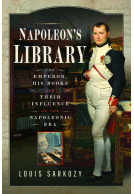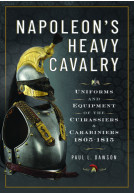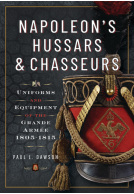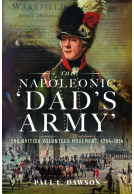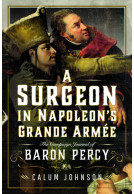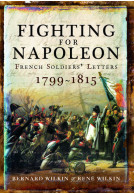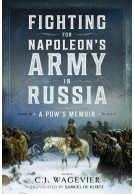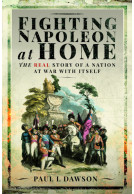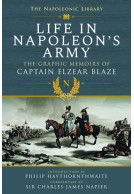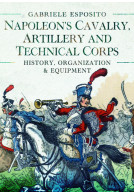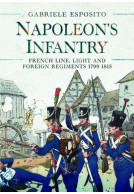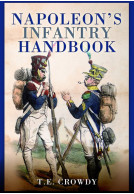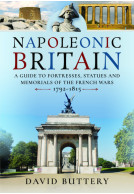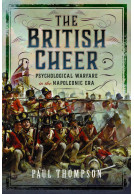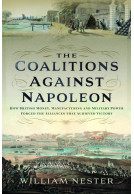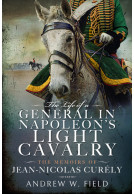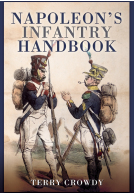255th Anniversary of Napoleon

Pen & Sword’s Napoleonic publishing caters for Napoleonic enthusiasts and for newcomers to this fascinating era of military history.
The range is wide, from campaign histories, biographies and memoirs to studies of battles and battlefield guides. Reissues of classic works of Napoleonic literature feature in the list, but it also includes outstanding, sometimes controversial new scholarship.
Readers who are keen to broaden their understanding of the Napoleonic Wars will gain a critical insight through the variety of books we publish on the subject.
Napoleon's Library (Hardback)
The Emperor, His Books and Their Influence on the Napoleonic Era
Napoleon Bonaparte held absolute political power in France and his influence stretched across Europe and beyond. Yet he remained – between leading his armies and ruling over a vast empire – an indefatigable reader who even carried libraries into battle.Bonaparte’s love of the written word, birthed in childhood and nurtured as an adolescent and young adult, never left him. He was a lover of literature for its own sake – often swooning over melodramatic love stories – but he also understood the value of books as instruments of power. Before his campaigns, he poured over dozens of texts relating to the relevant theatres’ geography, population, trade, and history. When contemplating grave decisions, such as his divorce to Empress Josephine, he consulted the historical record for useful precedents to justify and inform his actions. To bolster his troop’s morale during challenging times, he constantly referenced history in his proclamations, making his contemporaries feel as if they were actively shaping history. They were.
The library of an individual is the key to his mind. Behind the grandiose paintings of the victorious conqueror and the constructions of the propagandist, stands the reader. This book is an attempt to glimpse Napoleon’s character without the veneer of imperial glory.
What was he like, alone at night by his fireplace? What thoughts percolated in the mind of the ambitious 20-year-old, isolated in a little room while theorizing about man’s happiness? Who are the literary and historical figures which can claim to have had impacted his life? Who were his favourite authors?
Through this book the reader will embark on a literary promenade with the great general and statemen. In these pages are found the emperor’s favourite authors. And with them, the key to understanding his mind.
Napoleon’s Heavy Cavalry (Hardback)
Uniforms and Equipment of the Cuirassiers and Carabiniers, 1805-1815
Created during the Peace of Amiens, the nineteen regiments of cuirassiers that existed during the course of the 1e Empire were, after the Imperial Guard, perhaps the most famous and recognisable soldiers of the epoch. This book explores the long gestation of clothing and equipping the cuirassiers, the development of the arm from twelve regiments to twenty-one – if we include the carabiniers from 1811 – and how their clothing evolved across the period. As well as assessing the curiassiers, the story of the evolution of the uniforms of the carabiniers is also told. Much ink has been spilt on the two regiments and their uniforms, yet, as with the cuirassiers, precious little archive research has been carried out.This is one of a series of ground-breaking books which will be the defacto study of this perennially popular subject for historians, researchers, wargamers, re-enactors and artists. Using archive records to ‘set the record straight’, as well as contemporary illustrations and original items of uniforms, the author sets out to describe the uniform of every regiment of Napoleon’s army. Using archive sources found in the Archives Nationales and Service Historique du Armee de Terre in Paris, the author’s unrivalled research over a period of twenty years, will reveal exactly how, for the first time in over 200 years, Napoleon’s army was mounted, clothed and equipped.
Having been granted to access to over 1,000 archive boxes, the author assesses how the regulations were adopted in practice. This vast resource, as yet untapped by the majority of researchers and historians for understanding the Napoleonic era in general, include the many regimental archive boxes preserved in the French Army archives. These sources provide, potentially bias free empirical data from which we can reconstruct the life story of a regiment, its officers and above all its clothing. What did trumpeters wear? Did cavalry regiments really have sapeurs? We answer these questions and present the reality of how regiments were dressed derived from diaries, letters, inspection returns, regimental accounts and even cases of fraud.
For the first time, this unique series of books discusses the wide ranging 1806 uniform regulation and the more famous Bardin regulation which applied to all arms of the Army and explores the way in which regiments on campaign adopted and adapted their uniforms. For the first time since the days of Napoleon, we can say exactly what was worn by the French army.
Napoleon’s Hussars and Chasseurs (Hardback)
Uniforms and Equipment of the Grande Armée, 1805-1815
Small men, with big egos and moustaches, the hussars of Napoleon’s army wore some of the most flamboyant and stylish uniforms of the epoch. In this book, the uniforms of the seventeen regiments of hussars are discussed in detail by renowned historian Paul L. Dawson, along with the dress of their brethren in the thirty-two regiments of Chasseurs à cheval, with an emphasis on the highly elaborate dress of the trumpeters.Having been granted access to over 1,000 archive boxes, held in the Service Historique de l’Armée de Terre in Paris and the Archives Nationales, the author is able to assesses how the wide ranging 1806 uniform regulations and the more famous Bardin regulations were adopted in practice. This vast resource, as yet untapped by the majority of researchers and historians for understanding the Napoleonic era in general, provides detail never previously revealed to the general public.
This is possible because every year a regiment would be inspected, and the condition of the uniforms assessed. A return of all the clothing to be disposed of was made, and the appropriate number of new items ordered. Items of clothing and equipment needing repair were also recorded, as was how many pieces had been repaired since the last inspection. Upon joining a regiment, the recruit was given his first full set of clothing and equipment, which came from stoppages in his pay. Each item of clothing had a specified life – a bearskin had to last twenty years, for example. If the items needed repair or replacement inside the prescribed period due to misuse, the cost was borne by the soldier. All of this was recorded.
These invaluable sources provide bias free empirical data from which we can reconstruct the life story of a regiment, its officers and above all its clothing and equipment. In addition to the official records, the author has constructed how the regiments were dressed from diaries, letters, and even cases of fraud.
As well as providing the recorded details, this book shows in scores of beautiful illustrations exactly how each regiment appeared. These images include period paintings as well as works specifically commissioned for this book, plus unique photographs of existing items of uniform. Now, for the first time since the days of Napoleon, we can say exactly what was worn by Napoleon’s light cavalry.
The Napoleonic 'Dad's Army' (Hardback)
The British Volunteer Movement, 1794-1814
During the crisis year of 1792 when war against France was at its closest, a variety of societies and associations of ‘Loyal Britons’ were set up throughout Britain. Their aim was to organise patriotic, anti-French forces in defence of king and country, and to help maintain the established order.The need to provide an internal defence force resulted in the Volunteer Act of 1794. It witnessed the formation of hundreds of volunteer regiments on the upswell in loyalist sentiment following the disorder and instability witnessed across the Channel in Revolutionary France.
By 1798, there were 118,000 volunteers but, faced with the possibility of a French invasion of Southern England, William Pitt’s government aimed to expand this number substantially. By 1804 there were an astonishing 380,000 volunteers under arms and the various Corps made up half to one third of all the home service forces. When we add in those volunteers who agreed to serve overseas, as garrison troops in India for example, the number grows to approximately 800,000 – meaning that around one in every five adult males participated in military activities. This amazing groundswell of patriotic fervour has seldom been investigated before.
Using diaries and archive sources, this book seeks to explore the ‘Dad’s Army’ of the Napoleonic Wars. These men were far more than local bands of volunteers, they represented a militarisation of society not previously seen and which was repeated again when the world was thrown into war in the twentieth century.







